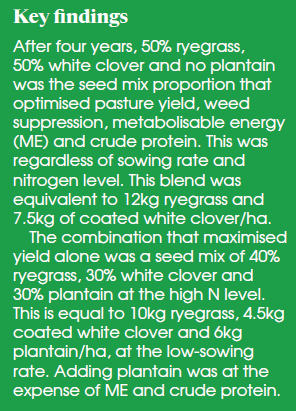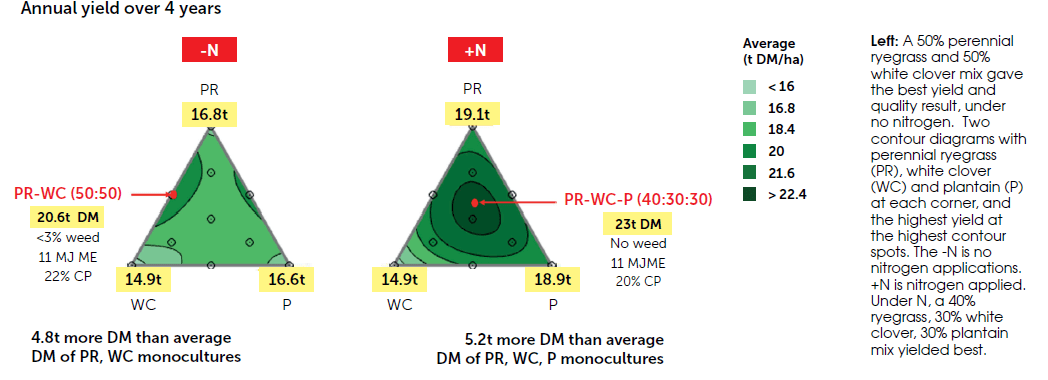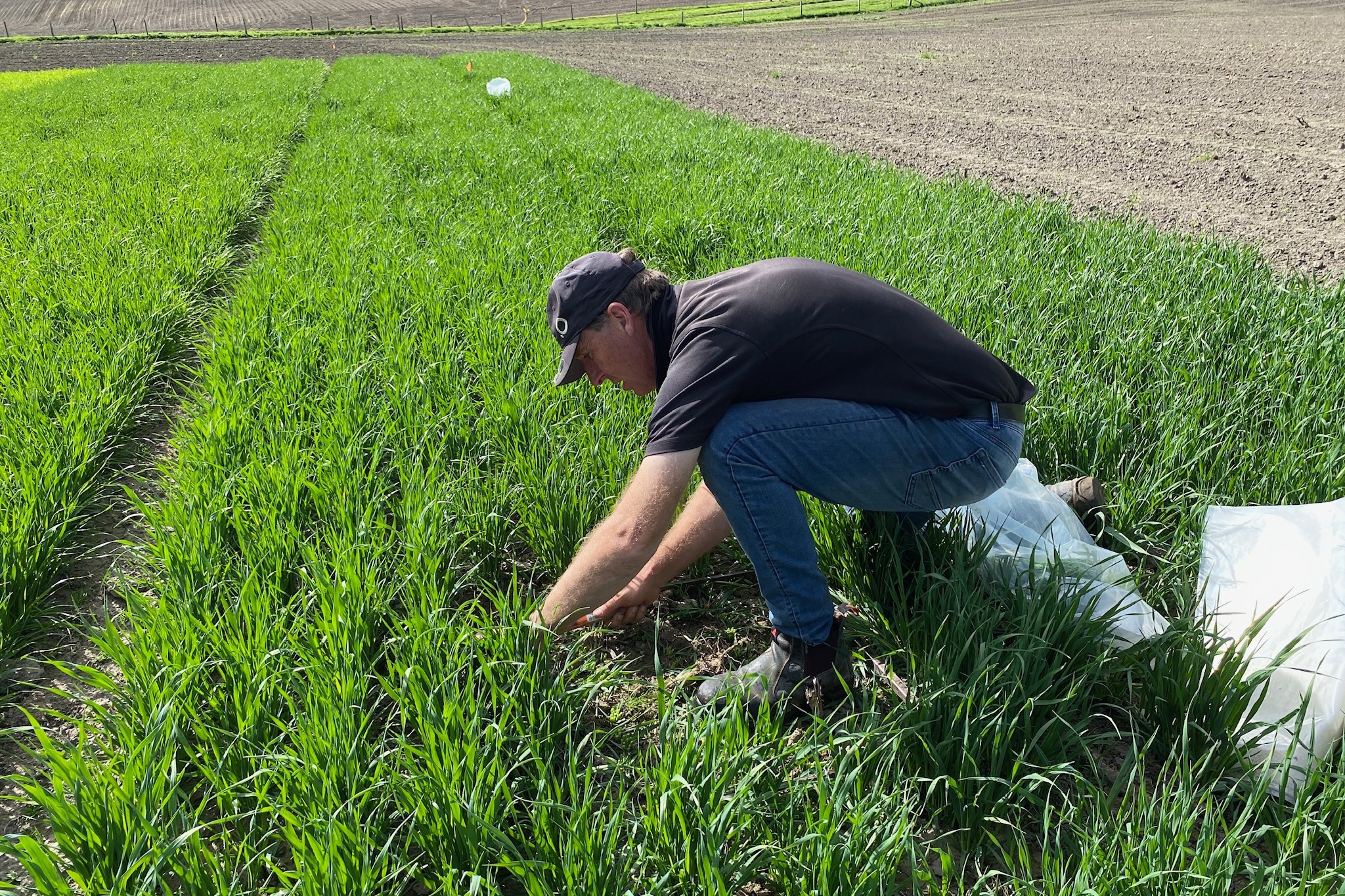PhD research from Lincoln University has found the best pasture mixes, Joanna Grigg writes.
Farmers wanting cheaper and better pasture feed, should look hard at the pasture composition first. Otherwise they could be wasting money both on nitrogen (N) fertiliser and needlessly buying extra seed.
At the NZ Grasslands 2022 conference in Southland, PhD student Thinzar Myint outlined the results of four years’ testing different seed mixes for permanent pasture and under different N applications.
“I know farmers are really interested in what pasture mix has the best yield or quality, with or without nitrogen,” she said.
Thinzar showed that pasture yield and quality are directly related to the proportions of species in a seed mix and the fertiliser N level applied after sowing, not the amount of the seed mix.
This means a pasture formed from any seed mix of the three species is expected to provide a yield and quality that will not change if the amount of seed mix is halved to 1000 seeds/square metre. That rate is the same as 12kg perennial ryegrass with 7.5kg coated white clover to the hectare (ha).

Thinzar presented a slide (see pasture slide) of one of the seed mix-by-N level relationships, for average pasture yield. It is called a contour diagram. The easiest way to interpret it is that the yield increases as you go up the hills of the contours.
This allowed her to identify which species to include in a seed mix and which ones to leave out.
She found ryegrass and plantain were most effective in increasing annual yield, but ryegrass was the most effective single ingredient for weed suppression.
All three species were equally high in metabolisable energy (ME) and white clover was most important in increasing crude protein.
Looking at the relationships closely, Thinzar found combining either ryegrass or plantain with white clover, will increase average yield and suppress weeds more than expected based on monoculture performances. This finding is also in line with farmers’ long-standing appreciation of the advantages of mixing N-fixing legumes such as white clover with grasses or herbs.
However, a less obvious but very important detail was that the yield increase of ryegrass/white clover mixes was almost twice as large as white clover/plantain mixes. This showed that combining ryegrass with white clover in a seed mix will have the largest impact on yield, making plantain an unnecessary ingredient of mixes where increasing yield and quality without bag N is a priority.
The key finding on N use was the 50:50 ryegrass/white clover seed mix that optimised pasture yield and quality did not change with increasing N levels. This might sit a few farmers back on their haunches. In fact, applying bag N nearly halved the white clover content in the sward, from 29% to 16%. Extra N increased the growth and quality of the ryegrass but the trade-off was lower legume.
The Hill Country Pastures Programme is funded by Beef + Lamb NZ, Ministry of Business, Innovation and Employment, Seed Force and PGW Seeds.
Lincoln University’s Alistair Black said Thinzar’s work showed the 50:50 ryegrass/white clover seed mix formed an equally productive pasture in a different way, without the costly urea.
With urea costing $1250/tonne as 2023 kicked off, a 190kg of N/ha application (via urea) will cost about $475 for the year. The year after research began, it was anticipated the Government would restrict N applied on grazed pasture. This was why the trial N rate was dropped to 200kg/ha, Black said. As expected, in 2021 Government legislation was brought in restricting all N applications to under 190kg N/ha/year.

Thinzar said this simple winning ryegrass white clover 50:50 combination grew 20.6 tonnes drymatter (DM)/ha/year with excellent weed suppression (unsown species contributed just 3% of the yield). It had high energy (11 megajoules (MJ) ME/kg DM) and crude protein (22%). All of this was regardless of N levels and without the associated greenhouse gas emissions from N fertiliser production and use. Sustaining the white clover power-house in the sward is the challenge.
Adding plantain and applying bag N can be considered if farmers want to maximise yield for a small drop in quality (about 0.2 units of ME and 2% crude protein), Thinzar said.
The combination of a seed mix of 40% ryegrass, 30% white clover and 30% plantain with bag N produced the greatest yield of 23t DM/ha/year. But it was just 2.4t/ha more than the ryegrass/white clover seed mix.
Adding the plantain without N fertiliser, did not improve yield and quality because it dropped the white clover content in the sward to 16%. This was because the white clover had less space and light to grow, which meant it couldn’t pump N into the soil at a rate required to feed the N-hungry ryegrass and plantain. Adding the bag N boosted the ryegrass and plantain but decreased the white clover content further to just 9% of pasture yield.
Pastures are always changing because of the complex grazing and growth synergy relationships.
In year one the ryegrass was building in proportion, but by the end of year two plantain was dominant, Thinzar said. By mid-year three, plantain had completely declined.
The pastures usually ended up with some weeds in them as well, with ryegrass being the most effective ingredient for weed suppression, doing without the need for herbicides.
Black said Thinzar’s work was well received by farmers and the seed industry at the conference.
“Both are looking for more science behind seed mix formulations for different farm systems, particularly in support of pre-prepared and marketed seed blends.”
Lincoln University is undertaking research on pasture mixes with legumes for dryland and irrigated pastures that need no or strategic N fertiliser.
Black said it is the key focus of the Dryland Pasture Research Team.




